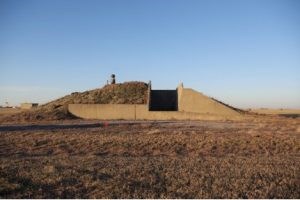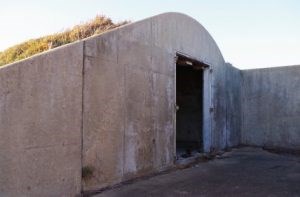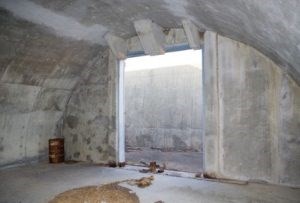Last updated: June 12, 2024
Article
Interpreting and Preserving Former Olathe Naval Air Station
This is a transcript of a presentation at the Preserving U.S. Military Heritage: World War II to the Cold War, June 4-6, 2019, held in Fredericksburg, TX. Watch a non-audio described version of the presentation on YouTube.
Changing Landscapes: Challenges of Interpreting and Preserving Cold War Era Military Resources at the Former Olathe Naval Air Station, Johnson County, Kansas
Presenter: Caitlyn Ewers
Abstract
The former Olathe Naval Air Station (ONAS) in Gardner, Kansas, was developed in 1942 in response to the increased need for air stations and naval reserve aviation bases as the United States entered World War II. Over the course of its three decades in operation, ONAS’s role was constantly in flux: it first served as a flight training facility for naval cadets, then as a training center and support facility for the Naval Air Transport Service in the latter years of World War II, and finally as a training center for naval reservists in the early years of the Cold War. Nationally, the operation of American naval bases declined sharply after circa 1960, and the ONAS was decommissioned in 1969. Johnson County, Kansas, acquired the property in 1973 and it is currently operated as a regional airport known as the Johnson County New Century Air Center. The overall landscape and many of the built resources that comprised the ONAS remain intact and actively in use.Due to the proposed release of airport property at New Century Air Center, a Memorandum of Agreement (MOA) was developed to mitigate adverse effects under Section 106 of the National Historic Preservation Act to a number of World War II and Cold War-era resources located on the former ONAS campus. In accordance with the MOA, one of the site’s three Cold War-era ammunitions magazines will be preserved in place. Burns & McDonnell historians have developed a preservation plan including methods for stabilization, public accessibility requirements, and interpretation via markers or signage. Identified in historic records as Ammunitions Magazine #129, this uncommon resource is a semi-cylindrical, board-formed concrete bunker that is partially concealed within a domed earthen mound. The entrance was originally covered by double-leaf steel doors and would have historically housed weaponry including guided missiles, propellants, and bulk high explosives. Due to its form, materiality, and location, Ammunitions Magazine #129 presents a unique array of preservation challenges related to physical conservation, access, and potential reuse.
This presentation and accompanying paper will provide a historic context for the development of ONAS, and its changing mission from the early 1940s through its decommissioning in 1969, and a summary of the preservation plan formulated for Ammunitions Magazine #129. In addition to physical examination of the resource in question, this study examines historic period blueprints, historic-age maps, aerial photographs, military logbooks, and secondary histories to understand the development of ONAS and the construction and use of Ammunition Magazine #129.

Presentation
Caitlyn Ewers: Today I'll be sharing with you one of our ongoing projects at the Olathe Naval Air Station, or ONAS, which is located in Johnson County about 20 miles southwest of Kansas City, Kansas. Commissioned and designed in 1942, the air station eventually grew from a small flight training facility for naval cadets and transport pilots, into a training site for naval reservists in the years that followed World War II. While it's currently used as the Johnson County Regional Airport, the property maintains a variety of buildings and structures related to its former military use. The 1940s administration building, for example, what you see here, has been rehabilitated and currently contains the offices of Johnson County Airport staff. A couple of early hangers also remain in active use on the west side of the site.
Even so, as the nature of the ONAS's use has continued to evolve over the past half century since its decommissioning, a number of the buildings and one of the runways constructed during the period of naval ownership have been underutilized and have become burdensome for the airport to maintain. In 2018, the Johnson County Airport Commission initiated plans to release almost 700 acres of their land for independent developers for commercial and industrial use. Seven resources, all of which are eligible for inclusion on the National Register, will be impacted as a result of this release. These resources are runways number 1331 which was constructed in 1942 as part of the own ONAS's first phase of development, munitions magazines 129, 130, and 131... And I apologize for the font, that shouldn't look like that. All of those were built in the Cold War era. And buildings 110, 110A, and 128, which were also constructed in the 1950s and reflect the new, more sophisticated navigation systems and communications equipment utilized by the US military at the time. Because the proposed land release requires approvals from the FAA, the undertaking is subject to compliance with NHPA in section 106 of the National Historic Preservation Act.
An environmental assessment was prepared for the project, and as part of the finding of no significant impact issued by the FAA, a memorandum of agreement was developed to mitigate adverse effects to the seven resources proposed for removal. Among other conditions, the MOA stipulated the ammunitions magazine number 29 would be preserved in place, and required development of a preservation plan to guide the structure's rehabilitation and interpretation. Because development plans for the property have not yet been finalized, the current plan is more of a general guide and the living document that will be updated as decisions are made regarding stabilization, public access and interpretation.
In this brief presentation, I'd like to provide a historic context summarizing the development of the ONAS and its changing mission from the 1940s through its decommissioning in 1969, as well as a summary of the standing preservation plan formulated for ammunitions magazine number 129. In addition to pictures of the site, this overview uses the original blueprints for the structure, historic age maps and aerial photographs, postcards, military logbooks, and secondary histories to understand the development of the ONAS and the construction and use of ammunitions magazine 129.

Burns & McDonnell Engineering
The development of the ONAS is reflective of a pattern of US military expansion prompted by growing conflict in Europe during the 1930s. In 1939, when the federal government realized that war in Europe was inevitable, Congress passed the Naval Reserve Act, which authorized the establishment of new training bases for thousands of naval reserve officers. In 1942, President Roosevelt issued an executive order directing the Navy to expand their fleet to 27,000 planes. And for perspective, the agency only had about 2,000 planes just the year before.
Prior to the Naval Reserve Act, there were 31 naval air fields in the US and abroad, but few were equipped to support war time training facilities. When President Roosevelt called in all naval reservists in the early 1940s, and aircraft production increased on an industrial scale, the existing infrastructure couldn't support recruit and reservist training requirements. The result was the commissioning of 20 new air stations and construction of two naval reserve aviation bases. Plans for the next year included commissioning of eight additional air stations, and nine reserve stations, this time including the ONAS.
Prior to World War II, Kansas had a very limited naval presence. Some training occurred at Fairfax Field here in Kansas City, which also served as the municipal airport. In 1941, a B-25 bomber plant was constructed at Fairfax Field, which then meant that it could no longer accommodate pilot training, so the navy began to look for another site for the Kansas City reserve.
In January of 1942, the Navy purchased a section of land between Olathe and Gardner and this included the nascent Johnson County airport. Construction of the ONAS facility began almost immediately with the first cadets arriving from Fairfax Field in July, 1962, only about six months after they'd purchased the land, but the station wasn't officially commissioned until October 1st.
In addition to the $73,000 spent on the land, over $12 million was expended on the base's initial development. Early priorities included construction of aircraft hangars, an assembly and repair shop, a ground school building, and storage facilities for 200,000 gallons of gasoline, as well as barracks and a mess hall. The navy also constructed three 5,000 foot runways including runway 1331. The initial phase of construction was complete by March, 1944 with the design intended to house about 2,000 enlisted men and a hundred officers, but construction continued after commissioning and by the end of the war, the facility could comfortably house, support and entertain 6400 men.
At its inception, the purpose of the ONAS was to provide primary flight training for naval cadets. The ONAS's role then shifted in 1944 when it became a major training center for transport pilots, and provided support facilities for the Naval Air Transport Service, which was responsible for expedited transport of both materials and naval personnel. During the war, the ONAS represented one of the largest transportation facilities in the country, operating 28 scheduled daily flights within the US, while also transporting supplies, mail, soldiers, and blood to the Atlantic and Pacific theaters. The ONAS was also the first to operate air evacuation flights which transported injured servicemen across the continental US.
By the end of World War II, the ONAS was the largest airport transport base in the country, and it was the mid-continent hub for transport operations. In the early postwar years, the ONAS remained busy supporting the return of men and supplies from around the world.
The ONAS's mission changed again after World War II, when the navy designated 17 naval air stations and five naval reserve stations as training sites for naval reservists. The ONAS was one of the facilities to receive this designation, and after the fall of '46 it supported the Naval Air Reserve and Marine Air Reserve training programs for the Kansas City Metro area. In 1946, the Naval Air Technical Training Unit was commissioned to provide air traffic controller and ground-controlled approach operator training.
Whereas the first air traffic controller positions were primarily staffed by the US Naval Reserve Class V-10 WAVES, the women accepted for voluntary emergency services, the role expanded following the approval of ground-controlled approach as the standard talk-down system. In late 1947, a basic air traffic control, shown here, was established at the ONAS, and in 1948 the two programs merged into the Naval Air Technical Training Unit which remained at the ONAS until 1962, sending students all around the world until the program was moved to Glynco, Georgia.
Within the ONAS, the proliferation of air traffic controller and ground-controlled approach professionals and the increasing sophistication of its equipment is reflected in three of the buildings that are slated for removal. Building number 110 is a radio receiver building that was constructed circa 1952. Building number 110A is an emergency power building associated with and constructed shortly after building 110. And building 128 is the ONAS's circa 1955 tactical air navigation systems building. Introduced in the mid-1950s these buildings are high frequency AMI range radio stations, and they send signals with a range of up to 200 miles. Building 128 was purpose-built to house an early iteration of this new military technology.
The continued success of the ONAS in the 1950s and early 1960s was directly related to the post World War II arms race between the US and the Soviet Union. The countries competed by building arsenals of both nuclear missiles and more conventional weaponry, resulting in the need for storage and training facilities for the ever-changing types of munitions that were being stockpiled. The vitality of this military industrial complex ensured the viability of the ONAS in the post war years and it correlates in time with the construction of these three ammunitions magazines on the property in 1956.
ONAS ammunitions magazines number 129, 130, and 131 were used only for installation ammunitions needs, as the nearby Sunflower Army ammunition plant and Nike missile bases were the primary regional facilities for production and storage of both conventional weaponry and nuclear warheads.

Burns & McDonnell Engineering
The magazines at the ONAS fit into broader trends of earth-covered munitions bunker designs that evolved by the mid-1950s to accommodate larger and more varied types of munitions. While the general size and shape of the standard arched roof remain unchanged, these Cold War era units were designed with wider openings covered by a set of double leaf steel doors to facilitate the movement of larger munitions. Other changes included the extension of ramps to accommodate the heavy equipment required to move the new forms of ordinance. Bunkers like these would generally have housed weapons like guided missiles, bulk high explosives, detonators and fuses or propellants, and they were never used for long-term storage of large quantities of ammunition, but rather for the immediate needs of the installation based on its training requirements. Large scale construction of new ammunition storage facilities in the US declined sharply after circa 1960, as did the operation of naval bases nationally.
The Navy announced the closure of the ONAS on October 29th, 1969 in an effort to reduce military spending, and the base was officially decommissioned in mid 1970. Johnson County acquired the property three years later and renamed it the Johnson County Industrial Airport. In '94 it was retitled The New Century Air Center and it still bears this name today.
The former ONAS currently includes a business park with more than 60 companies and a rail center, in addition to the active regional airport. More changes are coming soon as the Johnson County Airport commission moves forward with plans to release 671 acres for commercial and industrial development.
Runway 1331, ammunitions magazines 130 and 131, and buildings 110, 110A, and 128 are all proposed for removal, and ammunitions magazine 129 will be preserved in place in accordance with the MOA.
Still in search of a lessee, the preservation plan developed for magazine 129 is still in its earliest phases, and it will be updated and subject to coordination with the FAA and the SHPO prior to any action.
A little bit about ammunitions magazine 129, since it's the star of the show. It's a semi cylindrical board-formed concrete bunker, partially concealed within a domed earthen mound. And from historic aerials you can barely see it. Constructed in 1956, it's located about a third of a mile south of the intersection between two active runways. Sorry.
The entrance is shielded by a blast wall and it's located on the eastern facade. The paired steel doors that formerly covered the entryway, so you can see here, are no longer extant, and we haven't been able to find them despite their size and weight, but the seven inch deep steel doorframe, hooked metal door restraints and steel hinges all remain intact. The entry is accessible via a concrete walkway bounded by eight inch thick concrete retaining walls that extend the full height of the earthen mound. The interior of the building is a half cylinder with a maximum height of only about nine feet, as designed, and the space is about 25 feet wide from north to south, and 20 feet deep from east to west. The walls and ceiling are entirely blank apart from this single covered vent near the back wall. And this feature connects to a large rooftop ventilator that's capped with a bronze sleeved domed hood. Earth and vegetation have worn down surrounding the ventilator and that reveals this deteriorated waterproof membrane and the concrete beneath.

Burns & McDonnell Engineering
Pursuant to the MOA, a formal conditions assessment by a professional engineer or an architect will be conducted to determine appropriate preservation and stabilization protocol, but a preliminary overview of conditions issues has revealed both structural and cosmetic concerns. The eight inch thick retaining walls display vertical cracks of varying width, from broad fissures that expose the interior of the material, to fine hairline cracks. Narrow cracks in the walkway indicate that the foundation is settling and this ragged cleft that runs the perimeter of the interior suggests that the floor is at least partially separated from the walls. In addition to cracking, the concrete exhibits a variety of superficial damage and deterioration. Minor pitting and spalling are common to indicate moisture issues and subsequent damage from freeze-thaw cycles. So, this is Kansas. And orange microflora and efflorescence might suggest additional moisture concerns.
The rooftop ventilator, as you saw previously, is completely congested with decades of debris, and the ground cover has eroded away and resulted in significant deterioration of the waterproof membrane. When observed after a heavy rain, the interior of the resource, as you can see here on the lower right hand corner clearly exhibits the effects of moisture seepage. Interior moisture levels are presumably alleviated by the absence of the steel doors, but at the same time, the lack of a sealable entry exposes the interior to damage from the elements. It allows pests to freely access the space. We ran into a coyote once. And it diminishes the resource's integrity of design and materials.
Now, according to original blueprints, the extant steel doors on ammunitions magazines 130 and 131, which were built at the same time, are identical to the doors that were originally present on magazine 129, so reuse of these doors would be an option if either pair are determined to be in suitable condition for removal and re-installation.
Original blueprints are also useful in determining the volume of the earth fill that originally covered the roof of the magazine. Replacement of the doors in this ground cover will improve the resource's integrity of design, materials and feeling. And stabilization will also minimize future damage and support effective mothballing of the structure, which is not well-suited to adaptive reuse due to its form and location. A program of continued monitoring and regular maintenance will be implemented to ensure long-term preservation.
As to accessibility and safety, current plans include limiting public access to the interior of magazine 129 for visitors’ safety. However, access will need to be provided to allow observation of the exterior and associated interpretive panels or markers that will develop in accordance with the MOA. Access will probably be limited via security fencing with paved walkways that allow the public to view the exterior of the structure and associated interpretive materials. But formal design and development of an access plan will not be completed until the lessee for the property is secured.
Although access to the interior will be limited to authorized personnel for the foreseeable future, interpretive panels will be installed to provide the public with information regarding the history and function of the magazine, describing its role within the ONAS, as I have done, and commemorating the other buildings and structures that have to be removed. These will also be developed after we've identified a lessee for the property.
So as you can see, magazine 129 is a very unique military resource with an especially challenging array of preservation constraints. It's located in close proximity to an active airport. It's limited in ventilation, light, electrical connections, and floor space, and it's just not well suited to adaptive reuse, so probably be mothballed. Although this action will restrict access to the interior of the magazine, it's currently the most pragmatic option for its long-term preservation, and in the future should an appropriate reuse or interactive interpretation strategy present itself, then the resource can be reopened, but in the meantime, the exterior will remain accessible to allow the public to safely and meaningfully engage with the resource. The plans for this structure, until the lessee are identified are necessarily incomplete.
Now I'd like to take advantage of your experience and turn the discussion over to you. If you have any suggestions for access, reuse, or interpretation strategies, I would really welcome your input. There's still a lot of work to be done. Thank you.
Questions
Mary Striegel: Do we have questions for Caitlyn?
Speaker 1: Thank you, Caitlyn. I enjoyed your review with the ammunition magazines, and I was wondering, did these kinds of ammunition magazines not fall under the program comment for Cold War magazines?
Caitlyn Ewers: No, they didn't.
Speaker 1: It's a different kind?
Caitlyn Ewers: We worked with the Kansas SHPO and they determined that they did not.
Speaker 1: Oh, okay. Thank you.
Mary Striegel: Other questions?
Caitlyn Ewers: To add to that comment, I think most of that has to do with the fact that their station is now owned by the county. It was decommissioned back in the '70s so it's not subject to that program comment.
Speaker Bio
Caitlyn M. Ewers is an Assistant Cultural Resources Specialist at Burns & McDonnell Engineering Company, Inc. in Austin, Texas. Caitlyn is responsible for leading and assisting in cultural resource surveys, historic structure assessments, and archival research projects. Caitlyn received a Master of Science in Historic Preservation from the University of Oregon.
Read other articles from this symposium, Preserving U.S. Military Heritage World War II to the Cold War, or learn more about the National Center for Preservation Technology and Training.
